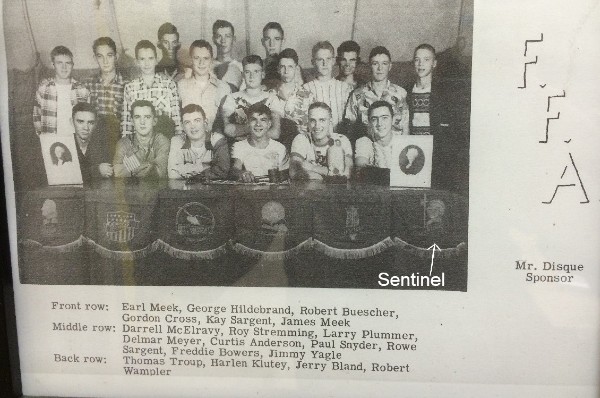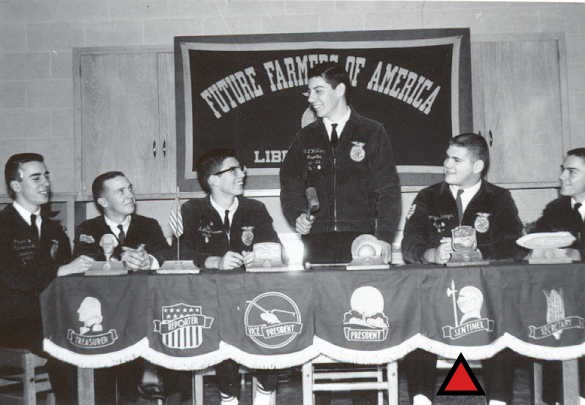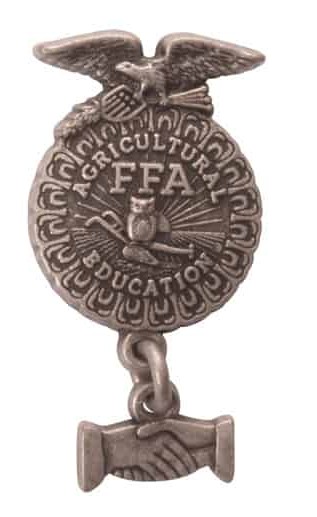Last week’s Friday Footnote about the optional FFA officers elicited some interesting dialogue and feedback so I have invited Dr. Jim Connors (University of Idaho) back to continue the conversation. Take it away Dr. Connors.
Thanks to input from several individuals and some additional research, this is a follow-up of the Friday Footnote titled Non-Constitutional FFA Officers published on May 29, 2020.
We’ve already learned that the Sentinel was not an original office included when the Future Farmers of America was founded in 1928. The office first appeared as the Farm Watch Dog. David Laatsch, retired agriculture teacher from Beaver Dam, Wisconsin reported that a father of one of his Beaver Dam FFA members shared that “his proudest accomplishments in school was serving as the Farm Watch Dog of the Beaver Dam FFA chapter.”
The minutes of the Joint Meeting of the National FFA Advisory Council and National FFA Officers on July 24-26, 1943 state that “It was moved by Vice President Stelter, seconded and carried, to remove the word “Farm Watch Dog” from the Manual and substitute the word “Sentinel.”
Once the Sentinel joined the ranks of FFA officers in the 1940s, it took some time to finalize the symbol that would represent the Sentinel. Kevin Cross, Agriculture Teacher in Sullivan, Indiana shared that his grandfather served as the President of the Sandborn FFA in Sandborn, Indiana in the early 1950s. A picture from his grandfather’s high school yearbook includes a banner for the Sentinel that includes a head of a knight in armor holding a spear or sword (bottom right in the photo). We don’t know exactly why the Sentinel displayed the picture of Thomas Jefferson.

We learned in an earlier Friday Footnote that an effort to have the FFA adopt the bulldog as a symbol for the Sentinel was defeated at the 1952 national FFA convention. The delegates at the 1952 national convention did asked the National Board of Directors to decide on a symbol of friendship for the Sentinel.
The issue of the symbol was discussed at the Board of Student Officers and Board of Directors meetings in both July and October of 1953. During the July 29th Joint meeting it was stated:
The next matter to come before the Board was the consideration of a symbol for the Sentinel’s Station. It was brought out that the delegates at the convention last year asked the National FFA Officers to design a symbol for the Sentinel’s Station. During a meeting of the Board of Student Officers, this matter was discussed and two suggestions were offered for a tentative symbol: (1) an open door; (2) clasped hands on a shield of friendship. The Board of Student Officers formally acted on this matter and decided to design a symbol for the Sentinel’s Station – the symbol to be “Clasped hands on a shield of friendship.”
It was moved by Don Travis, seconded by Fred Reed and carried that a symbol, depicting “Clasped Hands on a shield of friendship,” be designed for the Sentinel’s Station.
“It was moved by Mr. Watson, seconded by Mr. Johnson and carried, that the Board of Directors accept the recommendation of the Board of Student Officers with regard to this Symbol for the Sentinel’s Station.
At the October meeting the following action was taken:
Dr. Tenney then showed two samples of art work for a plaque for the Sentinel Station (Seal of Friendship). He stated that these would sell for approximately two dollars.
It was moved by Mr. Hunt, seconded by Mr. Naugher, and carried, that the recommendation of the Board of Student Officers be accepted – namely that the second pattern of art work on the Sentinel plaque be accepted.
Below is probably the design of the Sentinel’s officer station of the Hand Clasp on the Shield of Friendship that was first produced and sold in the 1950s.

However, it probably took some time for all chapters to adopt the new symbol. Another photograph has been found of an FFA officer team from the 1950s. This one shows the Sentinel seated behind the Hand Clasp officer station marker and a banner emblazoned with the knight in armor. This supports the photograph provided by Kevin Cross and indicates that before the Hand Clasp was adopted as the symbol of the Sentinel, the knight in armor was used.

Another piece to the puzzle of the Sentinel position comes to us from David Laatsch. David owns an officer pin for the Sentinel that has a sword attached to it. This would be similar to the spear or sword that the knight is holding on the Sentinel banner in the pictures above.

As we have known for some time, a lot of the symbols and traditions used by the FFA came from the Freemasons organization. Henry Groseclose and other original leaders of the FFA had been members of the Freemasons.
The Freemasons had two officer positions called the Inner Guard and the Outer Guard. Both would control entrance to the meeting room. One from inside the door and one from outside the door. These positions served as doorkeepers for the lodge meetings. The Outer Guard was also known as the Tyler. In historic times, many Masonic lodges met in inns or taverns. The origins of the term Tyler may have come from an Old English word for the “keeper of an inn door.” Because the Tyler served as the Outside Guard and doorkeeper, he usually had a drawn sword for protection (“Tyler,” 2020).
A book titled The Freemasons: The Illustrated Book of An Ancient Brotherhood (Johnstone, 2012) reports that, “…an Inner Guard and Tylers, or doorkeepers, one inside, the other outside, who are often armed with a ceremonial sword (p. 107).
New Farmers of America – Watchman
Did the New Farmers of America (NFA) have a Sentinel? No—but they had a Watchman. The 1946 NFA Guide lists six required NFA Officers (including the advisor) and had five additional officers that “May Be Added” along with the symbols of their office. These five optional officers were Watchman (straight stick of native wood about four feet long), Historian (Scrapbook), Parliamentarian (Stewart’s Helps in Mastering Parliamentary Procedure), Chaplain (Bible), and Song Leader (Baton). The 1962 edition of the NFA Guide was exactly the same.
According to the NFA Guide the duties of the Watchman are:
- Set up the meeting room and care for the chapter paraphernalia and equipment.
- Attend the door during meetings and welcome visitors.
- See that the meeting room is kept comfortable.
- Take charge of candidates for Degrees during initiation.
- Assist with entertainment features and refreshments.
Even though the Watchman was an optional officer the two chapter level degree ceremonies (Farm Hand, Improved Farmer) and the Honorary Membership induction ceremony all had speaking parts for the Watchman. This is true of both the 1946 and 1962 versions of the NFA Guide.
The 1961 Virginia Association of the New Farmers of America annual report lists the activities of the various NFA Chapters in Virginia. Two of the chapters (the Booker T. Washington Chapter in Rocky Mount and the Frederick Douglas Chapter in Northumberland) listed the names of their officers. Both had Watchmen.
Conclusions
After extensive research and assistance from many individuals, we have learned a lot more about the FFA Sentinel office. Dr. Rob Terry, Oklahoma State University, shared the following story from his days in the FFA:
“When I was a Greenhand member of the Stillwater FFA, the Sentinel had a unique method for assisting the president in maintaining order. Throughout the meeting, he (the Sentinel had always been a “he” – a big, burly he) kept a tally of those who talked or were otherwise disorderly. The last item of business prior to adjournment was the Sentinel’s Report. At that time, the Sentinel read the names of those on his list. The guilty parties had to pay a quarter for each mark (collected by the Treasurer, of course). If you didn’t have enough quarters, the Sentinel would paddle the violator for each infraction. To his credit, my agriculture teacher (who was a first-year teacher my freshman year) did away with that policy.”
To summarize what we have learned:
- The Sentinel was not listed as an officer position when the FFA organization was created.
- The Sentinel was not listed in the original constitution that the FFA adopted.
- The FFA delegates changed the Farm Watch Dog to the Sentinel in the early 1950s.
- The Knight in Armor with a sword was used as the first symbol for the Sentinel position.
- The position of Farm Watch Dog and Sentinel probably originated from the Outer Guard, Inner Guard, Tyler positions that served as doorkeepers in the Freemasons organization.
- The original officer pin for the Sentinel had a sword attached. Similar to the ceremonial sword used by the Freemason’s Tyler position.
- The National FFA Officers selected the Hand Clasp on the Shield of Friendship as the final symbol for the office of Sentinel.
- The NFA office of Watchman was very similar to the FFA Sentinel position.
 The Current FFA Sentinel Officer pin
The Current FFA Sentinel Officer pin
The Sentinel probably has the most interesting and convoluted history of any FFA officer position. While this office may be the last listed in the rank of officers, it is by no means any less important than the others. FFA Farm Watch Dogs or Sentinels and the NFA Watchman through the decades should be proud of their history and service to:
Keep the door open to our friends, making sure they are welcome, caring for the meeting room and paraphernalia, and assisting the President in maintaining order.
Contributors
This Friday Footnote could not have been possible without the knowledge and contributions of the following individuals:
- Dr. Gary Moore – for his research on the FFA Sentinel and NFA Watchman offices
- Mr. David Laatsch – for sharing the Sentinel pin with sword attachment.
- Mr. Kevin Cross – for sharing the experiences of his grandfather and picture of the Sentinel banner emblazoned with the knight of armor holding a sword.
- Dr. Rob Terry – for sharing his story of how the Stillwater FFA Sentinel maintained order during chapter meetings.
References
Future Farmers of America (1943). Minutes of the Joint meeting of the National FFA Advisory Council and National F.F.A. Officers – July 24-26, 1943. Indianapolis: Indiana University Purdue University Indianapolis Ruth Lilly Special Collections and Archives. http://www.ulib.iupui.edu/special/ffa
Future Farmers of America (1953). Minutes of meeting of the Board of Directors of the Future Farmer of America – July 29 – August 1, 1953. Indianapolis: Indiana University Purdue University Indianapolis Ruth Lilly Special Collections and Archives. http://www.ulib.iupui.edu/special/ffa
Future Farmers of America (1953). Minutes national FFA board of student officers – July 27 – August 1, 1953. Indianapolis: Indiana University Purdue University Indianapolis Ruth Lilly Special Collections and Archives. http://www.ulib.iupui.edu/special/ffa
Future Farmers of America (1953). Minutes of meeting of the Board of Directors of the Future Farmer of America – October 11-13, 1953. Indianapolis: Indiana University Purdue University Indianapolis Ruth Lilly Special Collections and Archives. http://www.ulib.iupui.edu/special/ffa
Johnstone, M. (2012). The Freemasons: The illustrated book of an ancient brotherhood. New York: Metro Books.
Tyler (Masonic). (2020, June 3). In Wikipedia. https://en.wikipedia.org/wiki/Tyler_(Masonic)
